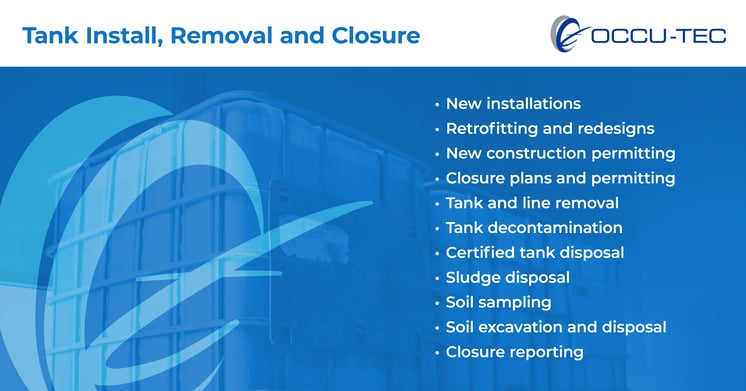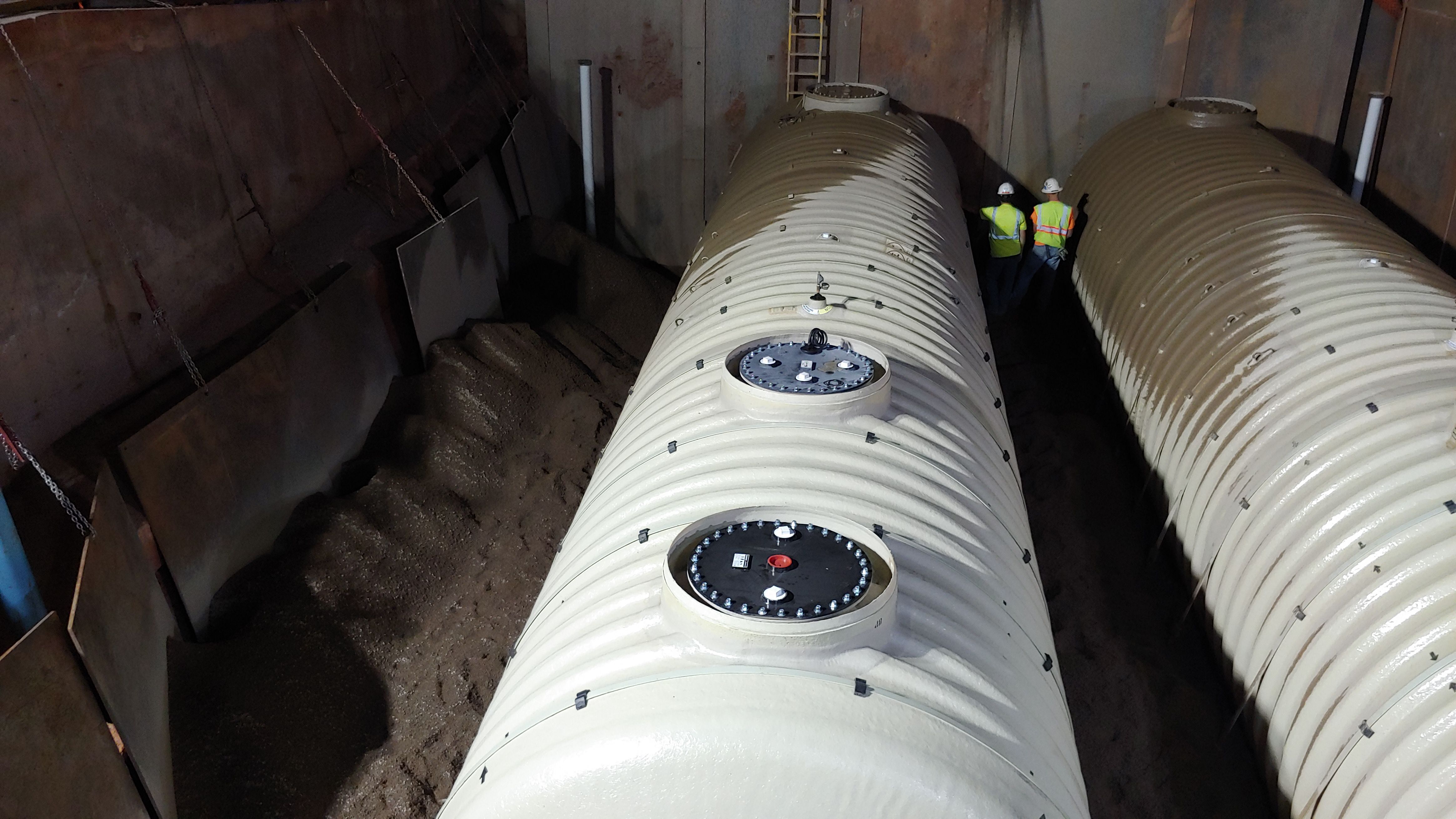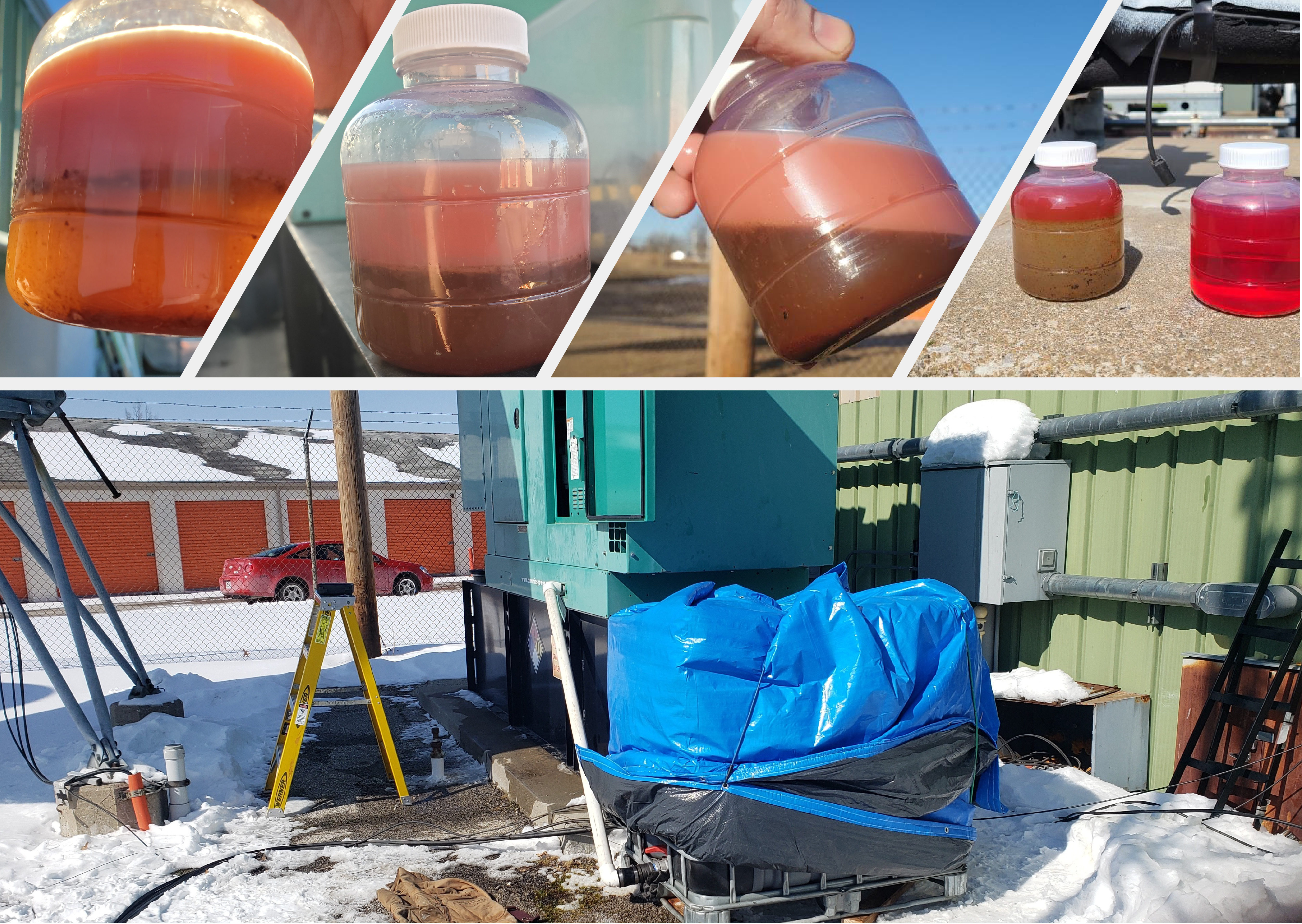7 min read
The Ultimate Guide to Emergency Power Systems for Commercial Developers and Business Owners
 OCCU-TEC, Inc.
:
Dec 11, 2023
OCCU-TEC, Inc.
:
Dec 11, 2023
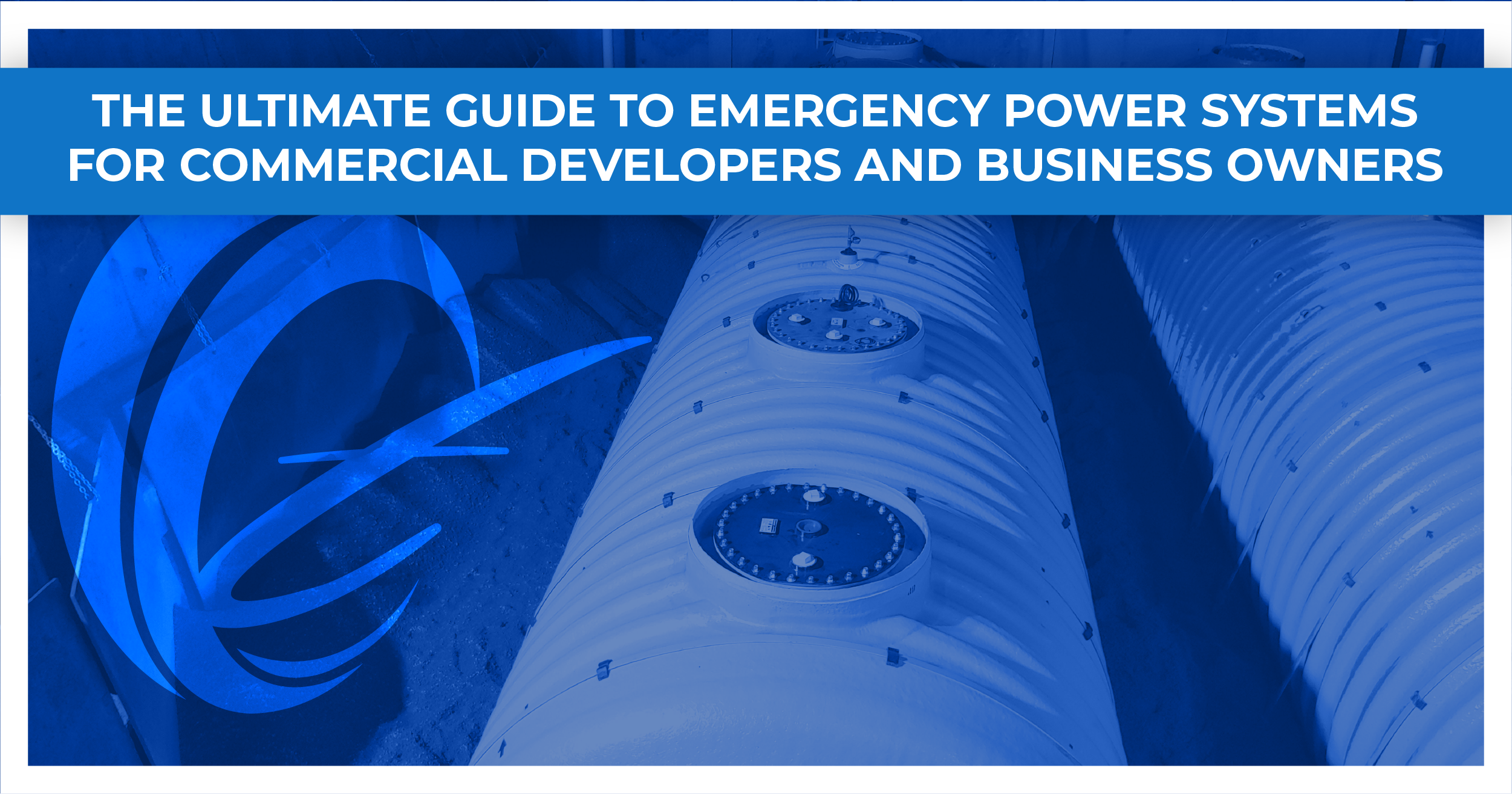
Every day around the country, we rely on essential services. From healthcare buildings to 911 operating centers and financial institutions, these services require reliable power, 24/7. If the power fails for even just a few minutes, people cannot continue to do their work, and there can be major consequences for companies and consumers.
That’s where emergency power systems (EPS) come in. These backup power systems are crucial for businesses and emergency services to ensure complete protection if the power systems fail. At OCCU-TEC we specialize in critical fuel systems, servicing EPS across the United States.
Understanding Emergency Power Systems
What Are Emergency Power Systems (EPS)?
EPS are systems that function as a backup power source for buildings during power outages and other emergencies. EPS include a generator that automatically activates within seconds of detecting a power outage, providing a seamless transition to backup power. EPS often come equipped with an automatic transfer switch, which senses when the primary power source is down and switches to the generator, ensuring that there's little to no interruption to power. Many EPS rely on diesel fuel systems to power the generators during commercial power outages.
The Role of EPS in Commercial Buildings
In commercial buildings, where continuous power supply is crucial for health and safety reasons, EPS provide a reliable backup power source to keep critical systems working. The systems reduce the risks of data loss, building downtime, and loss of safety measures during power outages. Without EPS, the consequences for commercial buildings can be significant.
For example, data servers around the world host essential data in specialized hardware. If that hardware overheats, it can lead to permanent data loss. Data centers have extensive cooling systems installed in those spaces that use a considerable amount of power to keep the hardware cool.
If the building were to lose power, building owners need a backup system to quickly kick on so that they can continue to keep the cooling system active to avoid overheating. Without an EPS, their hardware will quickly overheat, leading to data loss that may impact people and businesses around the world.
An emergency generator and its associated fuel system needs to be ready to go during a commercial power outage. Afterall, that’s exactly why it was installed in the first place.
For many businesses such as Telecommunications, Data Centers and Healthcare facilities, a building power failure is not an option and can be devastating. A power outage leads to high dollar fines, customer dissatisfaction, and even loss of lives.
These businesses can spend millions of dollars in designing and constructing their emergency backup generator systems. However, after construction ends, they don’t always invest similarly later on in preventative maintenance of the system.
Even when they do, they might overlook a crucial component of the emergency generator system. It can be easy to lose perspective that everything begins with the fuel, and the quality of that fuel is extremely important.
Benefits of EPS for Business Owners
Commercial EPS reduces the impact of outages and ensures that buildings remain operational during commercial power outages. This can save businesses from incurring significant losses during prolonged outages. The installation of EPS also helps businesses comply with regulatory codes and create a safer, more reliable business environment.
Types of Emergency Power Systems
Standby Generators
Emergency power systems are not one-size-fits-all. However, standby generators are the most popular forms of EPS as they can be built to size specifications to fit the needs of an individual commercial building. Size is one of the most critical factors to consider when selecting a standby generator. A generator that is too small for the building's needs will not be able to keep critical systems up and running, while a generator that is too large is inefficient and a waste of resources.
Other Types of Emergency Power Systems
- Backup Battery Systems: Best for sensitive electronic equipment, such as computers and servers, backup battery systems provide uninterrupted power for a short amount of time. These are not reliable EPS for entire buildings.
- Microgrid: These systems are created as a complete backup to support multiple buildings or entire communities. Microgrids use a combination of generators and renewable energy sources.
Regardless of the type of EPS is chosen, regular maintenance and testing of the generator motor and its respective fuel system are critical. Frequent tests ensure that the system works correctly and that any potential issues are identified early on and addressed before an outage occurs.
Integrating Solar Power for Emergency Needs
While solar power is becoming more popular for energy in many sectors, it is not yet reliable enough for use as an emergency power system for commercial buildings. That said, solar power can contribute to daily and emergency power systems, harvesting sunlight and turning it into immediate usable energy. Solar power is very useful for charging smaller power systems such as backup batteries and small equipment.
EPS Best Practices for Commercial Developers
Planning for EPS During Building Design
EPS are required for many commercial buildings. While regulations vary from state to state, there are similar considerations when planning the installation of an EPS. Building designers need to determine the needed capacity, identify the location of the EPS, and ensure the system aligns with the building's electrical infrastructure.
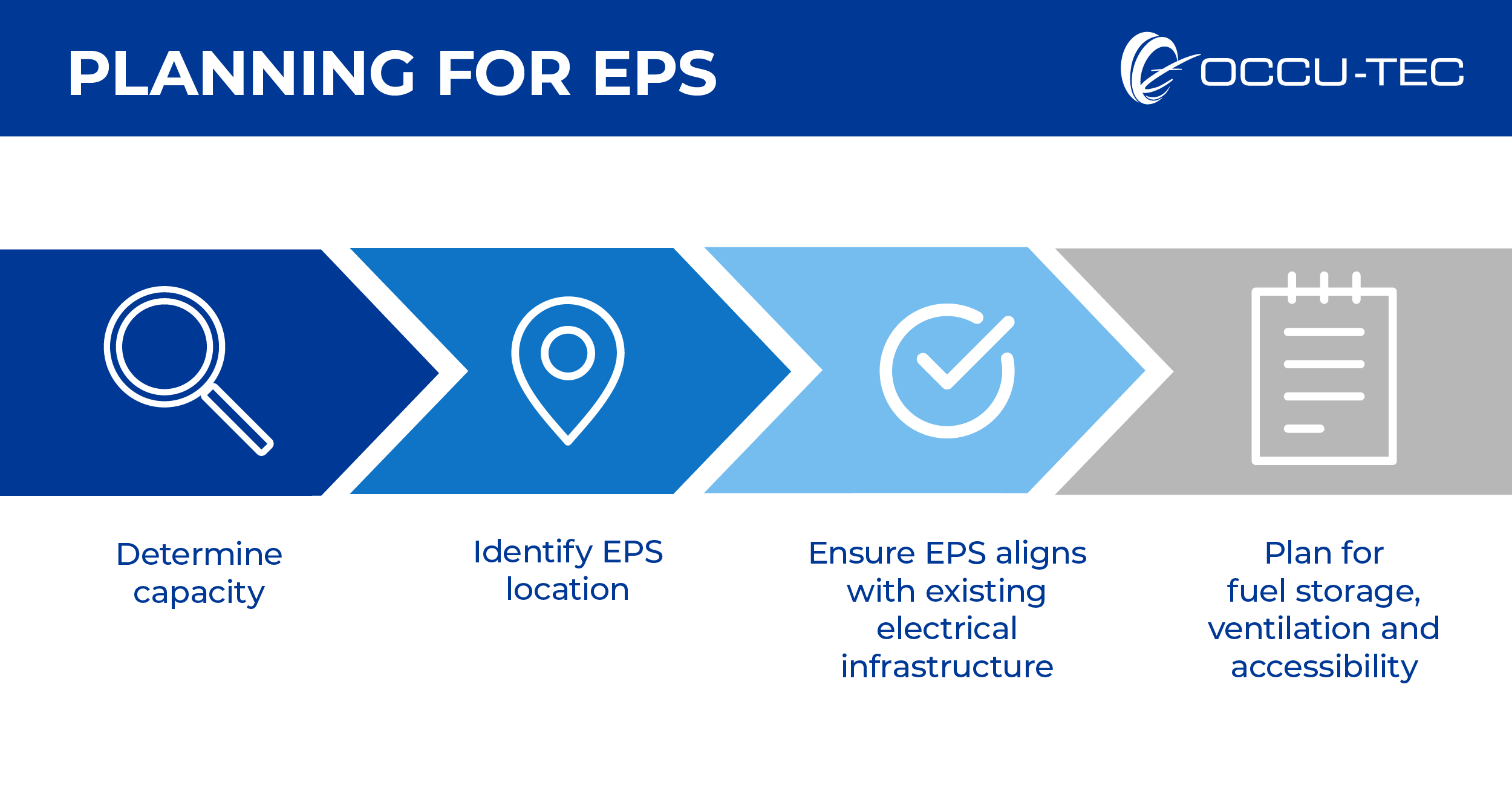
In addition, designers need to plan for fuel storage, ventilation, and accessibility for maintenance. All these considerations must be made in a way that minimizes environmental challenges and safety risks.
Compliance with Local Codes and Regulations
Each state and municipality has different requirements for EPS design and overarching federal requirements. These codes and regulations mandate routine inspections and tests to monitor the EPS and environmental testing to ensure safety and minimal impact on the surrounding area, among other things. New Environmental Protection Agency (EPA) Underground Storage Tank Rules effective as of 2018 have placed even more focus on the inspection and testing of EPS fuel systems.
Local codes and regulations are changing every day. That’s why at OCCU-TEC, we continuously work closely with those regulators to stay in compliance with regulations and anticipate future changes.
Routine Testing and Maintenance Procedures
Routine testing and maintenance are crucial for ensuring continued safety and EPS readiness during an emergency. Regular testing and maintenance procedures must be conducted to diagnose and report any system issues that require immediate attention. That’s where OCCU-TEC comes in.
OCCU-TEC offers comprehensive solutions to critical fuel systems that power standby generators and other emergency power systems. From tank installation to tank and fuel quality management and tank removal and closure, our services are designed to give building owners peace of mind from the very beginning to the very end of the fuel system’s lifetime.
Emergency Fuel Systems
With satellite offices and a network of fuel vendors strategically positioned across the country, OCCU-TEC provides high-quality fuel systems services quickly and reliably.
Tank and Fuel Quality Management
The right fuel tank program with fuel testing and treatment reduces costs and protects vital company assets during normal operations and unexpected emergencies. To maintain tank and fuel quality standards, OCCU-TEC provides:
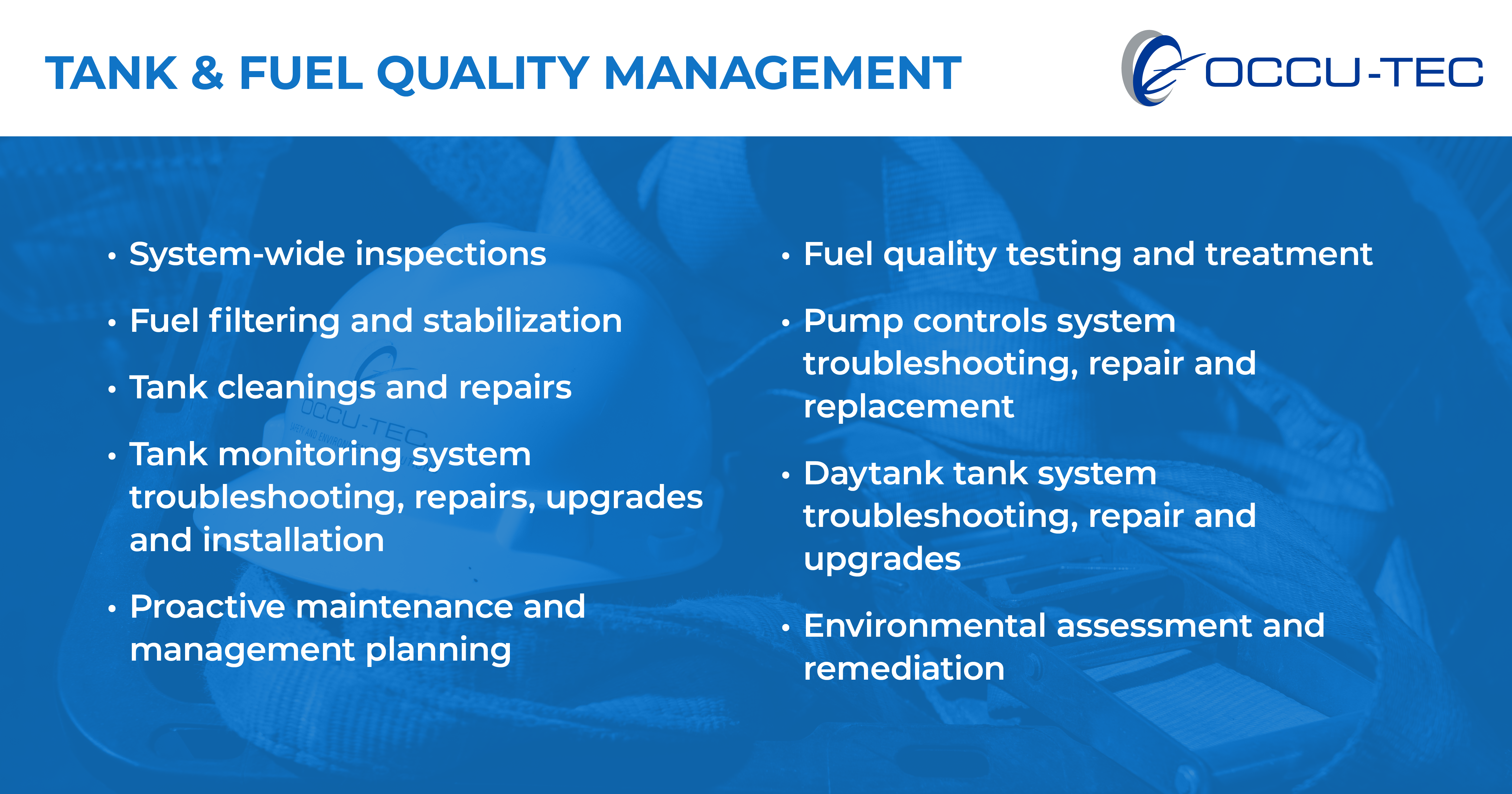
Preventing Fuel Quality Problems
It’s mostly straight forward. Emergency generator owners must have a solid preventative maintenance program that includes routine sampling of their fuel tanks. They need to have a professional who knows what they are doing and is consistent during each sampling event.
Collecting Fuel Samples
Fuel samples need to be collected with consistency and in a fashion that represents the fuel that is picked up by the pumps feeding your generator or smaller holding tanks (daytanks). A fuel sample collected from the very bottom of your fuel tank although useful for visual analysis, isn’t the sample you necessarily send off for laboratory analysis.
Likewise, a fuel sample collected upstream from generator fuel filters isn’t going to represent what is happening inside the fuel tank near the draw (pickup) point of your tank. Instead, the sample should be pulled from an interval that best represents where fuel is drawn from your tank. This interval can certainly vary, but it is generally between 1” and 6” from the tank bottom.
The actual draw point can be verified via fuel system drawings, interior inspection reports, construction photos or other means. We generally collect representative fuel samples from 1”-2” off the tank bottom when the draw point is unknown, which is the case most of the time. Also, if water is already present in the tank bottom, we will collect the sample a minimum of 1” higher than the water level.
Remember, we want to get analytical results on the fuel, not the water. If there is water on the tank bottom, there is already a problem to remedy so use your sample budget to better understand the fuel quality so you can add the proper treatment into your work plan to remedy the water problem.
How do we collect a fuel sample from a particular fuel interval in the tank without cross-contaminating it with other fuel in the tank?
Sampling devices known as “bacon bombs” can help you achieve this goal. They remain closed and empty until you reach the interval you want and then can be opened to capture fuel and closed prior to extracting them from your fuel tank. Another way to extract the sample is by using a hand pump and tubing with some finesse using a tank stick and tubing zip-tied at the inch level you want to collect from.
Why would we send a sample from the tank bottom that is half full of water only for the lab to tell us there is water in your fuel? We already know there is a problem if the fuel sample has visual evidence of water, therefore collection of a representative sample from above the water line and sending that for laboratory analysis is generally a better practice and more useful in designing or enhancing the overall fuel treatment action plan.
What is a Comprehensive Fuel Analysis?
Opinions may vary throughout the industry and can also become very situational. There are several types of fuel analysis available that can provide you detail ranging from general fuel quality to much more detailed analysis such as proving a fuel’s specifications. Striking an economical balance is the key for an entry level comprehensive analysis suite and might contain the following analysis:
- ISO Cleanliness (ISO 4406)
- Distillation (D-86)
- Water by Karl Fischer method (D-6304)
- Water & Sediment (D1796)
- API Gravity (D-287)
- Cetane Index (D-976)
- Micro-Organisms (D6469)
We used these same analysis for several years as part of many fuel sampling programs. However, in 2020 an extreme weather event changed the way many see fuel quality in the Midwest when a polar vortex hit the country and temperatures fell well below normal averages for several days. Although low temperatures are nothing abnormal for the Midwest, the duration of those extreme low temperatures lingered much longer than average, which caused some significant generator failures due to fuel gelling conditions.
Through previous consulting prior to the event, some customers had laboratory data that provided them some indication of their fuel’s cold weather resistance. This data helped them make decisions and generate action plans before fuel system problems surfaced. Other customers were blind sided by generator failure due to fuel flow problems during the event. Therefore, we recommend the following additional tests when providing a baseline comprehensive fuel quality analysis.
- Cloud Point (D7689)
- Cold Filter Plug Point (D6371)
Tank Install, Removal and Closure
OCCU-TEC helps businesses interface with regulatory authorities to coordinate installation, retrofit, or removal of fuel systems to achieve a positive outcome for both our customers and the agencies. Our tank install, removal and closure services include:
Key Considerations for Choosing a Commercial EPS Provider
Ensuring your business has a reliable EPS partner and regularly maintaining your EPS are the first steps in ensuring smooth operation during an outage. At OCCU-TEC we specialize specifically in critical fuel systems. Unlike our competitors, who take on multiple disciplines or point-of-sale fuel systems, our team exclusively works with emergency generator fuel systems.
This unique aspect of our work makes us a leading service provider. Because our team focuses on emergency power systems, we have developed a vast amount of technical knowledge and business acumen that helps us deliver efficient solutions to our clients. We’ve also developed a large, national network of fuel and parts providers, allowing us to deliver products and services to job sites faster than our competition.
Our installation, inspection, maintenance, and removal teams have decades of experience educating our clients on the importance of critical fuel systems, performing reliable work, and preparing our clients’ systems for emergencies.
Conclusion: It's Time to Check on Your Emergency Power System
If your business can’t afford to lose power (and whose can?), an emergency power system is the best way to protect your building and the people who rely on it. At OCCU-TEC, we make critical fuel system installation, maintenance, regulation compliance, and removal simple. Let our skilled team take care of everything for you. Contact us today to learn more.

